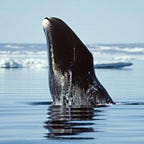A Place of Coming Together: Harrison Bay & Colville Delta
by: Melanie Smith
The story of Harrison Bay begins where the Rocky Mountains end. The long spine of western North America takes a left-hand turn across Alaska’s Arctic, forming dramatic peaks that poke and stretch through a thin skin of tundra. Here, the Brooks Range forms the natural southern boundary of Alaska’s North Slope, where numerous tributaries flow past Dall sheep, grizzly bears, and caribou, coming together to form one of the Arctic’s longest and largest rivers: the Colville. Headwater streams drop quickly through steep terrain, forming a river that cuts a more relaxing grade through the foothills where wolverines lope and raptors soar. The exposed Lower Cretaceous cliff banks of the Colville are tenanted by nesting peregrine falcons, golden eagles, rough-legged hawks, and gyrfalcons.
Nearing the Beaufort Sea, the river slithers slowly across the Arctic coastal plain before it gently approaches the village of Nuiqsut. Home to about 400 people, this small Alaska Native community sits at an invisible but important boundary: a transition from the heavily developed State of Alaska oil production lands to the federal National Petroleum Reserve — Alaska (NPRA) which is just beginning to see its first oil production footprint. Nuiqsut also sits near where the Colville Delta begins — a massive alluvial fan and delta plain fingering out toward the Beaufort Sea.
This is a place of coming together, of gathering. It is a globally recognized Important Bird Area: nestled among the ponds, oxbows, tussocks, and polygons of the Delta, a world-class gathering of shorebirds and waterfowl raise their chicks on the tundra. Black brant, Steller’s eiders, stilt sandpipers, and over 60 other species breed here. Listen and watch: A pair of yellow-billed loons yodels a call to proclaim their territory. A female spectacled eider dabbles for aquatic insects. A group of American golden-plovers probes the mudflats to fatten up, preparing to make their 10,000-mile autumn flight back to South America. Arctic foxes, musk oxen, wolves, caribou, and the occasional land-locked polar bear wander through the Delta.
The Colville Delta is so flat and braided that it is indiscernible where the river ends and the ocean begins — saltwater intrudes many tens of miles inland, and freshwater mixes many miles out to sea. The vast estuary gradually morphs into the shallow waters of Harrison Bay. The western bay is delineated by Cape Halkett near Teshekpuk Lake, an extension of land that holds the waters somewhat separate and sheltered from the greater Beaufort Sea. The eastern bay ends at approximately Oliktok Point where a long chain of barrier islands heads east, crossing through Prudhoe Bay.
Few non-local people ever visit the Delta. Even fewer yet study or visit Harrison Bay. Yet the small number of aerial, at-sea, and telemetry studies point to this place as one of ecological significance. Twenty-two species of fish are known to live in Colville River waters, including several anadromous species such as Arctic cisco and pink and chum salmon that live in the waters of Harrison Bay. Spotted seals gather at a coastal haulout in the eastern delta. Usually solitary red-throated and yellow-billed loons gather in the bay in staging groups to prepare for their migration to China’s Yellow Sea. King and spectacled eiders flock together also, preparing for their molt migration back to wintering areas in the Bering Sea. Many other species gather and feed in the nutrient-rich waters that host an abundance of marine birds that is among the highest known densities in the U.S. Beaufort Sea.
The unassuming topography from Colville Delta to Harrison Bay is an area that can be overlooked in the vastness of Alaska’s famed mountains and expanse of the Arctic Ocean. But this is a place to look more closely — where ecosystems intertwine, where life begins, and wildlife gather — where an extraordinary abundance of Arctic wildlife carry out their humble daily tasks of hatching out a living for another season. This is a place for us to come together to take notice.
About the author: Melanie Smith is an Arctic spatial ecologist. As the Director of Conservation Science for Audubon Alaska, she applies geospatial analysis and mapping to identify key conservation areas for Alaska’s birds and other wildlife.
